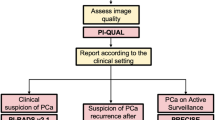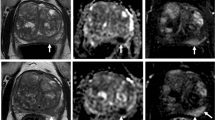Abstract
Objective
To determine whether a radiomics signature (rad-score) outperforms ADC in TSR estimation by developing a radiomics biomarker for preoperative TSR diagnosis in rectal cancer.
Methods
This study included 149 patients (119 and 30 in the training and validation cohorts, respectively). All patients underwent T2-weighted, diffusion-weighted, and contrast-enhanced T1-weighted imaging. A rad-score was generated using the least absolute shrinkage and selection operator (LASSO) algorithm and stepwise multivariate logistic regression. Meanwhile, the mean ADCs were calculated from ADC maps. For both the mean ADC and rad-score, binary logistic regression and Spearman correlation coefficients were used to determine associations with the TSR, and the area under the receiver operating characteristic (ROC) curve was used to assess the diagnostic performance. The reliability of the rad-score was quantified by comparing the imaging-estimated TSR with the actual TSR of each patient.
Results
Both the mean ADC and rad-score were positively correlated with the TSR in the training cohort (mean ADC: p < 0.001, r = 0.566; rad-score: p < 0.001, r = 0.559) and validation cohort (mean ADC: p < 0.001, r = 0.671; rad-score: p = 0.002, r = 0.536). The rad-score, with AUCs of 0.917 (95% CI 0.869–0.965) and 0.787 (95% CI 0.602–0.972) in the training and validation cohorts, respectively, outperformed the mean ADC (training cohort: AUC = 0.776, 95% CI 0.693–0.859; validation cohort: AUC = 0.764, 95% CI 0.592–0.936) in TSR estimation.
Conclusion
The ADC possesses potential diagnostic value for TSR estimation in rectal cancer, and the rad-score shows increased diagnostic value over the ADC and may be a promising supplemental tool for patient stratification and informing decision-making.
Key Points
• Tumor-stroma ratio has been verified as an independent prognostic factor for various solid tumors including rectal cancer.
• The ADC and multiparametric MRI-based radiomics features were significantly and positively correlated with the tumor-stroma ratio in rectal cancer.
• The radiomics signature outperformed the ADC in discriminating TSR in rectal cancer.






Similar content being viewed by others
Abbreviations
- ADC:
-
Apparent diffusion coefficient
- CRC:
-
Colorectal cancer
- DWIs:
-
Diffusion-weighted images
- LASSO:
-
Least absolute shrinkage and selection operator
- ROC:
-
Receiver operating characteristic
- TSE:
-
Turbo spin-echo
- TSR:
-
Tumor-stroma ratio
References
Siegel RL, Miller KD, Jemal A (2019) Cancer statistics, 2019. CA Cancer J Clin 69:7–34
Miller KD, Nogueira L, Mariotto AB et al (2019) Cancer treatment and survivorship statistics, 2019. CA Cancer J Clin 69:363–385
Giraldo NA, Sanchez-Salas R, Peske JD et al (2019) The clinical role of the TME in solid cancer. Br J Cancer 120:45–53
Li X, Wang P, Li D et al (2018) Intravoxel incoherent motion MR imaging of early cervical carcinoma: correlation between imaging parameters and tumor-stroma ratio. Eur Radiol 28:1875–1883
Downey CL, Simpkins SA, White J et al (2014) The prognostic significance of tumour–stroma ratio in oestrogen receptor-positive breast cancer. Br J Cancer 110:1744–1747
Peng C, Liu J, Yang G, Li Y (2018) The tumor-stromal ratio as a strong prognosticator for advanced gastric cancer patients: proposal of a new TSNM staging system. J Gastroenterol 53:606–617
Labiche A, Heutte N, Herlin P, Chasle J, Gauduchon P, Elie N (2010) Stromal compartment as a survival prognostic factor in advanced ovarian carcinoma. Int J Gynecol Cancer 20:28–33
West NP, Dattani M, McShane P et al (2010) The proportion of tumour cells is an independent predictor for survival in colorectal cancer patients. Br J Cancer 102:1519–1523
Huijbers A, Tollenaar RA, Pelt GW et al (2013) The proportion of tumor-stroma as a strong prognosticator for stage II and III colon cancer patients: validation in the VICTOR trial. Ann Oncol 24:179–185
Moorman AM, Vink R, Heijmans HJ, van der Palen J, Kouwenhoven EA (2012) The prognostic value of tumour-stroma ratio in triple-negative breast cancer. Eur J Surg Oncol 38:307–313
Geessink O, Baidoshvili A, Klaase JM et al (2019) Computer aided quantification of intratumoral stroma yields an independent prognosticator in rectal cancer. Cell Oncol (Dordr) 42:331–341
Mesker WE, Junggeburt JM, Szuhai K et al (2007) The carcinoma-stromal ratio of colon carcinoma is an independent factor for survival compared to lymph node status and tumor stage. Cell Oncol 29:387–398
Driessen JP, Caldas-Magalhaes J, Janssen LM et al (2014) Diffusion-weighted MR imaging in laryngeal and hypopharyngeal carcinoma: association between apparent diffusion coefficient and histologic findings. Radiology 272:456–463
Ko ES, Han BK, Kim RB et al (2014) Apparent diffusion coefficient in estrogen receptor-positive invasive ductal breast carcinoma: correlations with tumor-stroma ratio. Radiology 271:30–37
Scheer R, Baidoshvili A, Zoidze S et al (2017) Tumor-stroma ratio as prognostic factor for survival in rectal adenocarcinoma: a retrospective cohort study. World J Gastrointest Oncol 9:466–474
Almangush A, Heikkinen I, Bakhti N et al (2018) Prognostic impact of tumour-stroma ratio in early-stage oral tongue cancers. Histopathology 72:1128–1135
Liu H, Zhang C, Wang L et al (2019) MRI radiomics analysis for predicting preoperative synchronous distant metastasis in patients with rectal cancer. Eur Radiol 29:4418–4426
Cui Y, Yang X, Shi Z et al (2019) Radiomics analysis of multiparametric MRI for prediction of pathological complete response to neoadjuvant chemoradiotherapy in locally advanced rectal cancer. Eur Radiol 29:1211–1220
Schurink NW, Min LA, Berbee M et al (2020) Value of combined multiparametric MRI and FDG-PET/CT to identify well-responding rectal cancer patients before the start of neoadjuvant chemoradiation. Eur Radiol 30:2945–2954
Cui Y, Liu H, Ren J et al (2020) Development and validation of a MRI-based radiomics signature for prediction of KRAS mutation in rectal cancer. Eur Radiol 30:1948–1958
Meng X, Xia W, Xie P et al (2019) Preoperative radiomic signature based on multiparametric magnetic resonance imaging for noninvasive evaluation of biological characteristics in rectal cancer. Eur Radiol 29:3200–3209
Fu M, Chen D, Luo F et al (2020) Association of the tumour stroma percentage in the preoperative biopsies with lymph node metastasis in colorectal cancer. Br J Cancer 122:388–396
Li XT, Sun YS, Tang L, Cao K, Zhang XY (2015) Evaluating local lymph node metastasis with magnetic resonance imaging, endoluminal ultrasound and computed tomography in rectal cancer: a meta-analysis. Colorectal Dis 17:O129–O135
Acknowledgments
This study has received funding from the National Natural Science Foundation of China (grant number: 81971687) and Shanghai Sailing program (grant number: 19YF1409900).
Funding
This study has received funding from the National Natural Science Foundation of China (grant number: 81971687) and Shanghai Sailing program (grant number: 19YF1409900).
Author information
Authors and Affiliations
Corresponding author
Ethics declarations
Guarantor
The scientific guarantor of this publication is Tong Tong.
Conflict of interest
The authors of this manuscript declare no relationships with any companies whose products or services may be related to the subject matter of the article.
Statistics and biometry
No complex statistical methods were necessary for this paper.
Informed consent
This study is retrospective study and does not require informed consent.
Ethical approval
Institutional Review Board approval was obtained.
Methodology
• retrospective
• diagnostic or prognostic study
• performed at one institution
Additional information
Publisher’s note
Springer Nature remains neutral with regard to jurisdictional claims in published maps and institutional affiliations.
Electronic supplementary material
ESM 1
(DOCX 193 kb)
Rights and permissions
About this article
Cite this article
Cai, C., Hu, T., Gong, J. et al. Multiparametric MRI-based radiomics signature for preoperative estimation of tumor-stroma ratio in rectal cancer. Eur Radiol 31, 3326–3335 (2021). https://doi.org/10.1007/s00330-020-07403-6
Received:
Revised:
Accepted:
Published:
Issue Date:
DOI: https://doi.org/10.1007/s00330-020-07403-6




